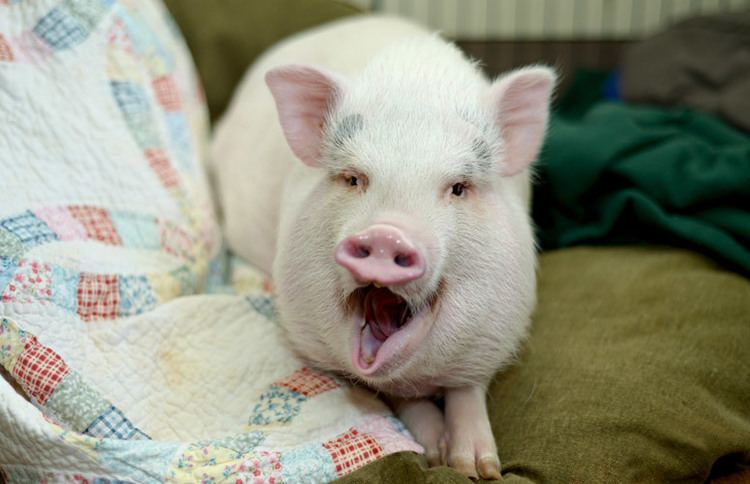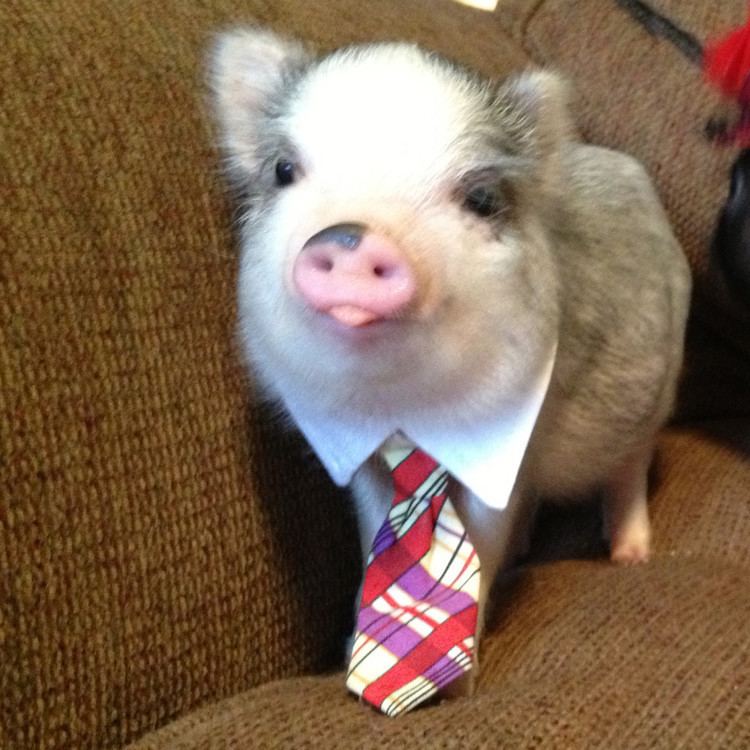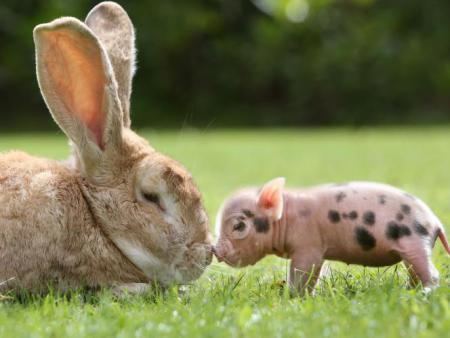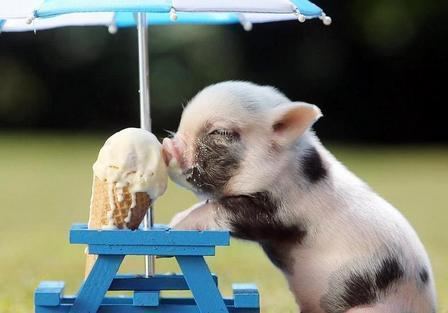Scientific name Sus scrofa domesticus Higher classification Domestic pig | Rank Breed | |
 | ||
Similar Pot‑bellied pig, Kunekune, Pygmy goat, Mangalica, Pug | ||
Apex sa miniature pig breeding
A miniature pig (also mini pig, or micro pig, or teacup pig, or "designer pig", or "nano pig", or "apartment pig", or "pocket pig") is a breed of pig developed and used for medical research or as a pet. Miniature pigs weigh between 22.5 kilograms (50 lb) and over 68 kilograms (150 lb) when fully grown. 'Mini pig' has become an acceptable, if imprecise, term that is used to distinguish the difference between farm pigs and smaller breeds such as Pot-bellied pigs, Choctaw Hog, Kunekune (and specimens derived by cross breeding with these). There are no breeds called teacup or micro or even mini. These are all adjectives and not breeds of pigs.
Contents

History

In the 1960s, Chinese pigs that grew to be 150–200 pounds (68–91 kg) were sent to zoos in Western cities and were used for medical research in the fields of toxicology, pharmacology, pulmonology, cardiology, aging, and as a source of organs for organ transplantation. These comparatively smaller pigs were easier to work with than the larger farm pigs, which typically reach weights of 300-500 pounds. Pot-bellied pigs also became a fixture in many zoological parks where their small stature, sway backs, and potbellies attracted the attention of visitors. The purchase of a few potbellied pigs by wealthy pet owners helped start a new trend in pet pigs. However, much like many pigs purchased by the public, the majority of the celebrities did NOT keep their pig. We collected a list of celebrity pigs and where they're at now linked below.

The popularity of miniature pigs grew in the 1980s, with pet potbellied pigs appearing everywhere from New York apartment complexes to small hobby farms. However, the trend was short-lived, mostly due to city ordinances forbidding raising farm animals within the city limits. Furthermore, many owners came to realize that even a 75 kilograms (165 lb) pig was difficult to handle in most housing situations.

The 1990s and 2000s saw a rising trend of marketing pet pigs that were supposed to be much smaller than even the potbellied pigs, and therefore suitable pets for house and apartment owners. While multiple animal protection groups and pig breeders question or deny the existence of true "miniature pigs", there are currently breeders selling piglets claimed to be miniature pigs in North America and in the United Kingdom. The word "mini" or "miniature" has been accepted as a term to differentiate between farm pigs and potbellied pigs, but in no way describes the sizes of "mini" pigs. Realistic sizes of pigs vary from pig to pig, genetics drives the growth along with appropriate nutrition and care. The misleading terms have grown to include other adjectives to represent breeds that do not exist.

In the mid-1980s, Keith Connell of the Bowmanville Zoo in Ontario imported breeding potbellied pigs to Canada, which became the foundation for the potbellied pig in North America. Because of customs laws, only their offspring could be sold in the United States. US zoos were the main target for the piglets, but private owners soon began purchasing them as pets. Up to five additional imports were made in the following 10 years. To track the pedigrees, the Potbellied Pig Registry Service, Inc (PPRSI) was created to preserve these bloodlines and establish a breed registry in the United States. This registry was dissolved in the late 1990s.
The Miniature Potbellied Pig Registry Service, Inc (MPPRSI) was established in 1993 to provide a registry for those pigs who were pedigreed in the PPRSI and met the breed standard, when fully grown not being more than 37 centimetres (15 in) tall and weighing under 25 kilograms (55 lb). All of the foundation pigs were dual registered in PPRSI and MPPRSI. ANYONE can create a registry, that doe NOT mean your pig is that particular breed. This is a marketing gimmick and typically leads people to believe the information is credible. In reality, the purpose of registries is for sales purposes. There is no breeding stock where the genetics have been followed to prove the pigs bred now are anything different than the potbellied pigs that were introduced to the USA in the 1980's. However, there IS proof that people starve their pigs and stunt their growth.
Medical research
Miniature pigs have been used for medical research, including toxicology, pharmacology, experimental surgery, pulmonology, cardiology, xenotransplantation, and aging. Scientists genetically modified the pigs' genomes in order to create smaller pigs for medical research since pigs can be useful in studying human disease and due to their high intelligence, are easy to manage in a laboratory setting. For example, scientists are working on studying the possibility of utilizing pig hearts for human heart organ transplant and work has been done to genetically modify the tissues of pigs to be accepted by the human immune system.
The Göttingen minipig (or Göttinger or Goettingen Minipig) is a breed of miniature pig developed for use in biomedical research. Beginning in the late 1960s at the Institute of Animal Breeding and Genetics (Institut fϋr Tierzucht und Haustiergenetik) at the University of Göttingen, Germany, the breed was developed by crossbreeding the Minnesota minipig, the Vietnamese Potbelly Pig and the German Landrace pig.
In May 2015, the China Academy of Agricultural Science announced that its research team had successfully produced F-25 (the 25th generation) of inbred Chinese Wuzhishan Mini Pig (WZSP), with an inbreeding coefficient of 0.99519.
As pets
Miniature pigs can be pets. They are very intelligent animals (4th smartest among mammals), or according to David DiSalvo writing in Forbes they are "widely considered the smartest domesticated animal in the world" -pigs ... can move a cursor on a video screen with their snouts and even... learn to distinguish between the scribbles they knew from those they saw for the first time...) and can be easily house-trained. They can also be taught how to go through a doggy door or ring a bell at a door to notify their owners if they need to go outside. They are supposedly hypoallergenic and often do well with people that have usual animal allergies as they have hair and not fur. (Some people have had allergy testing and ARE allergic to pigs though) They do, however, "blow their coat" meaning that they shed most of the longer hair once a year, usually in Spring or early summer to prepare for the warmer months ahead. Because pigs do not sweat (the often used term "I'm sweating like a pig" is a misnomer since pigs only sweat a small amount from their snouts), they shed to help keep cool in the warmer summer months. This can often be a hassle as they can shed a large amount of long, stiff hair that can pierce through the skin if stepped on or embedded in clothing. It is common for the pig to gain bald spots or be mostly bald through summer and fall, and most of the hair will grow back. Though the main assumption about pigs is that they are very dirty animals, in fact, they will usually only get muddy or dirty when provided with a much needed outside area to gain vitamin D from sun/rooting soil and grass for a diet, and use the mud as a sunscreen or cooling agent to keep their body temperature regulated. Wallowing, as it is referred to, is when a pig will root up a certain area of dirt and roll around in the mud to get a nice layer of mud on their skin to protect against the sun and as a bug repellent.
Breeders claim that micro pigs can potentially make great pets, but that there are considerably more risks involved when buying a micro pig over other common pets, such as cats or dogs. The biggest concern is that, since there is no established breed of "teacup pig", there is no guarantee that the pig sold as such will actually stay small. It may be possible to reduce the risk of ending up with a large pig by looking at the pig's parents and grandparents if possible. However, since pigs can breed years before they fully mature, unscrupulous or ignorant breeders may show off parent pigs which are not fully grown themselves, so have not reached their full adult size. Some breeders may falsely claim that a mini-pig is guaranteed to stay under a certain weight, and sometimes will recommend a diet regimen that starves the animal and unnaturally stunts its growth. Pigs need enrichment activities to keep their intelligent minds occupied, if pigs get bored, they often get destructive.
Some towns and cities have ordinances disallowing farm animals within city limits; a pig is usually considered a farm animal regardless of their size. However, you can petition city councils and have outdated ordinances amended BEFORE you add a pig to your family since many were put into place before the potbellied pig was even introduced to the US. Many small animal vets will not treat pigs. You will need to find a vet that is willing to see pigs before you bring a pig home. Many educational websites for pigs have collected and verified veterinarians that do. Since these animals have a life span of 15 to 20 years, they require long term commitment. Due to their ability to bond, combined with their need for attention, people who have limited time for a pet may find a pig far more than they can handle. Additionally, if pet pigs are not properly trained when they are young, they can strive for dominance and become aggressive. There are methods to retrain pigs that have not been trained properly though. Normally, there is a reason a pig acts out aggressively such as not being neutered, starved or abused.
There are multiple animal rescue organizations set up to find new homes for pet pigs which have grown too large or otherwise unmanageable for their owners.
